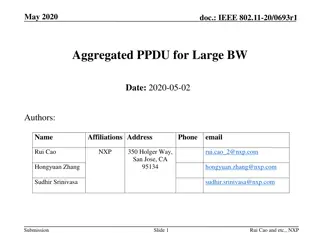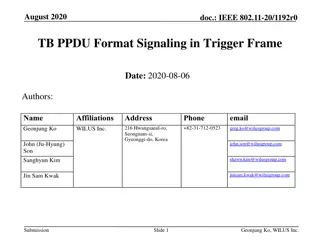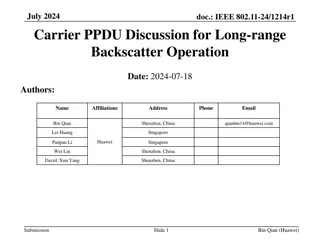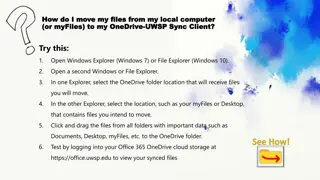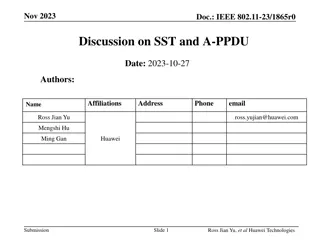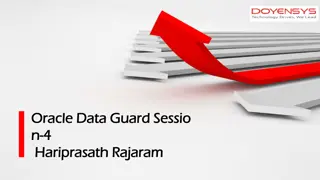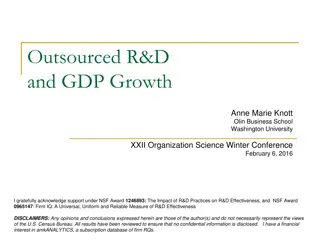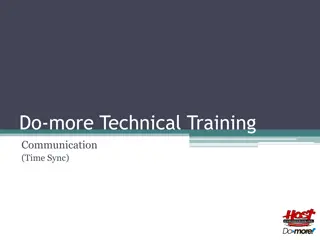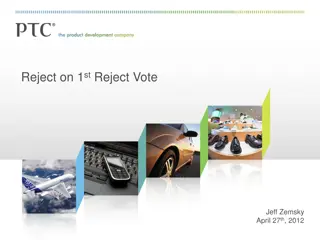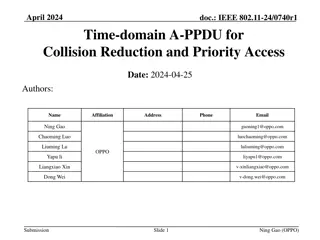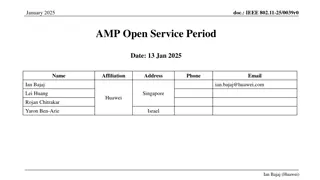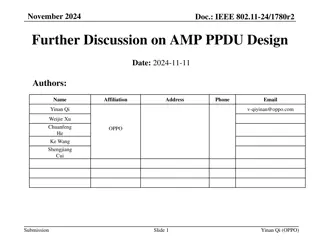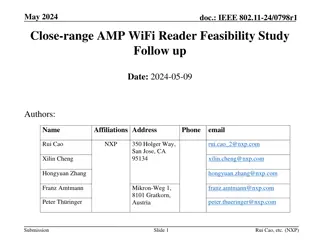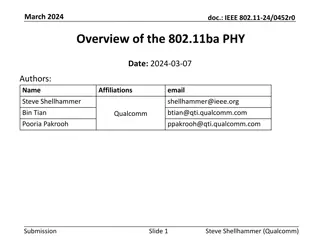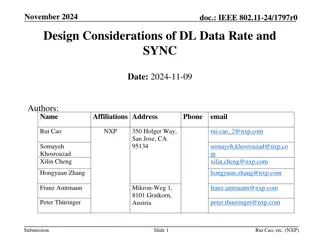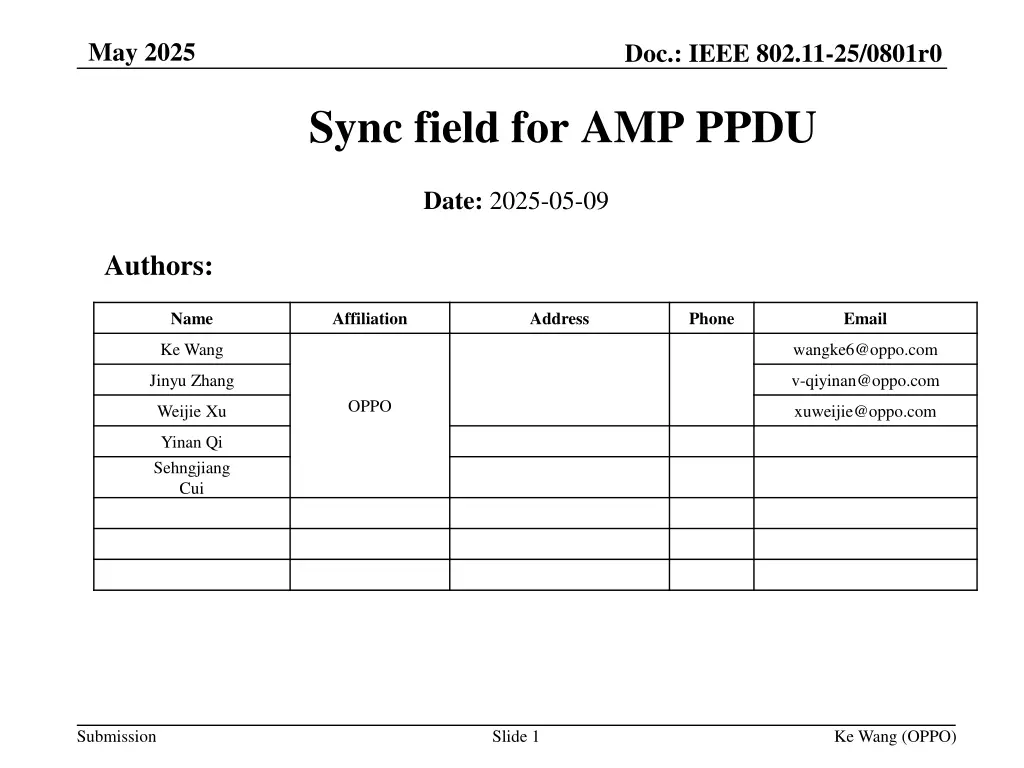
IEEE 802.11-25/0801r0 Sync Field Optimization Proposal
In this document, a proposal is presented to optimize the sync field design for AMP PPDU regarding false alarm issues. The discussion includes design criterions, sync performance, and further evolution plans for IEEE 802.11bp group. Various sync sequences, lengths, and chip durations are analyzed, with a focus on addressing detection challenges and improving synchronization efficiency.
Download Presentation

Please find below an Image/Link to download the presentation.
The content on the website is provided AS IS for your information and personal use only. It may not be sold, licensed, or shared on other websites without obtaining consent from the author. If you encounter any issues during the download, it is possible that the publisher has removed the file from their server.
You are allowed to download the files provided on this website for personal or commercial use, subject to the condition that they are used lawfully. All files are the property of their respective owners.
The content on the website is provided AS IS for your information and personal use only. It may not be sold, licensed, or shared on other websites without obtaining consent from the author.
E N D
Presentation Transcript
May 2025 Doc.: IEEE 802.11-25/0801r0 Sync field for AMP PPDU Date: 2025-05-09 Authors: Name Affiliation Address Phone Email Ke Wang wangke6@oppo.com Jinyu Zhang v-qiyinan@oppo.com OPPO Weijie Xu xuweijie@oppo.com Yinan Qi Sehngjiang Cui Submission Slide 1 Ke Wang (OPPO)
Doc.: IEEE 802.11-25/0801r0 May 2025 Abstract In our previous contribution[1][2][3], sync field for AMP PPDU has been intensively discussed, including the design criterions /requirements for AMP sync. The sync performance including sync timing performance, its impact on data decoding etc., were intensively studied for various candidates of sync sequence, sync length and chip duration. In this contribution, false alarms issue is identified based on further study. We propose to further optimize the sync filed design to address this issue. In addition, we propose the design criterions and a set of simulation assumption to 802.11bp group for further evolution campaign. Submission Slide 2 Ke Wang (OPPO)
Doc.: IEEE 802.11-25/0801r0 May 2025 Recap: High-level requirements for AMP sync In [1][2][3]. the following requirements for AMP sync are discussed. Different sync sequences for DL/UL for indication. Support two different AMP DL rate e.g. 1Mbps and 250kbps using 2 different sync A correlator can distinguish between Sync length 16 and 32. The Sync sequence has the same number of 1 and 0. Good auto-correlation The sequence have 3 consecutive 1/0, which can help distinguish synchronization field and data field with Manchester coding. Submission Slide 3 Ke Wang (OPPO)
Doc.: IEEE 802.11-25/0801r0 May 2025 Recap: Sync sequence length(1) For length 8, the auto-correlation is not so good and cross-correlation with random Manchester symbols become unacceptable. One sequence after computer searching is '10001101' AC_H: -4 AC_L: 2 Cross-correlation with Random Manchester symbols Submission Slide 4 Ke Wang (OPPO)
Doc.: IEEE 802.11-25/0801r0 May 2025 Recap Sync sequence length(2) For length 16, the auto-correlation and cross-correlation with random Manchester symbols were evaluated. It shows good auto-correlation. And with limited samples of data, no big issue is observed for cross- correlation. One candidate sequence after computer searching is '1100100101011100' Cross-correlation with Random Manchester symbols AC_H: -4 AC_L: 4 Submission Slide 5 Ke Wang (OPPO)
Doc.: IEEE 802.11-25/0801r0 May 2025 False alarms issue(1) The identified sync sequence can well meet the design requirements as listed in slides 3. Note that the design requirements are very similar as what are used for WUR sync sequence. However, as we further evaluated the cross-correlation between the sync sequence and data field with more samples of random Manchester coded data symbols. It is found that the cross-correlation property is not good enough to avoid false alarm detection in the data portion!!! Although obvious peak is detected in the sync field, there are lots of high side lode peaks in the data field. The ratio of the peak in sync field to the highest peak in data field is very small, only 32/24 for the 16bits sync sequence. Sample rate =2M, Date duration = 2us, sync duration =2us Sample rate =8M, Date duration = 2us, sync duration =2us 30 100 Sync length 16bits 20 50 Sampling rate 2MHz/8MHz 10 50 20 Chip duration of sync 2us 0 0 0 0 -50 -20 Chip duration of data 2us -10 -50 -100 X 108860 Y -24 -40 X 422064 Y -96 7.99 8 8.01 -20 3.2 3.202 3.204 105 104 X 80064 Y -32 -100 X 320256 Y -128 Data length 10000bits -30 -40 -150 0 2 4 6 8 10 12 14 16 18 0 1 2 3 4 5 6 7 104 105 Cross-correlation between sync and Random Manchester data symbols Submission Slide 6 Ke Wang (OPPO)
Doc.: IEEE 802.11-25/0801r0 May 2025 False alarms issue(2) Then in the same way, we further evaluate the cross-correlation property of WUR sync sequence. The cross-correlation with data part becomes slightly better (the ratio is 64/40), but still not acceptable. Sample rate = 2M, Date duration = 2us, sync duration = 2us Sample rate = 8M, Date duration = 2us, sync duration = 2us 40 200 150 WUR Sync length 32bits 20 20 100 0 0 50 Sampling rate 2MHz/8MHz -20 0 -100 -40 0 -60 Chip duration of sync 2us -200 -20 -50 7.995 8 8.005 8.01 8.015 104 X 90084 Y -40 3.2 3.204 3.208 -100 X 405488 Y -160 105 Chip duration of data 2us -40 -150 X 80128 Y -64 -200 X 320512 Y -256 -60 Data length 10000bits -250 -80 -300 0 2 4 6 8 10 12 14 16 0 1 2 3 4 5 6 7 104 105 False alarm will results in bad receiving performance at the AMP STA It will affect the sync timing performance and degrade the data decoding performance. It will also waste AMP STA s power, when data decoding is triggered by a false peak in the data field (Note that an AMP STA may wake-up and begin to receiver DL PPDU when one AMP DL PPDU is transmitting). Submission Slide 7 Ke Wang (OPPO)
Doc.: IEEE 802.11-25/0801r0 May 2025 Analysis of False alarms issue Why is there so severe false alarm issue? The sync field is one pseudo binary sequence and the data part, though with Manchester coding, is also random binary sequence. There is probability that for some data bits segment, the binary bits sequence will has high correlation with the sync sequence. Submission Slide 8 Ke Wang (OPPO)
Doc.: IEEE 802.11-25/0801r0 May 2025 Revisiting requirements for AMP sync(1) With the above new findings and analysis, we propose to revisit the design requirement for AMP Sync: Can differentiate DL PPDU with UL PPDU. Can indicate two different AMP DL rates The Sync sequence has the same number of 1 and 0. Good auto-correlation The sequence have 3 consecutive 1/0, which can help distinguish synchronization field and data field with Manchester coding. Good Cross-Correlation Submission Slide 9 Ke Wang (OPPO)
Doc.: IEEE 802.11-25/0801r0 May 2025 Metrics to evaluate Auto-Correlation Assuming: S1 is the sync for high data rate. S2 is the sync for low data rate. Local reference sequence: Ref = 2 ?local 1 Correltion_H = xcorr( S1 ,Ref) Correltion_L = xcorr([S2],Ref) The following metrics can be defined to evaluate auto- correlation ??? Correltion_H 2nd??????? Correltion_H ???= ??? Correltion_? 2nd??????? Correltion_? ?? = ???(???) + ???(???) ???= Submission Slide 10 Ke Wang (OPPO)
Doc.: IEEE 802.11-25/0801r0 May 2025 Metrics to evaluate Cross-Correlation It shall maintain low cross-correlation between sync and other field of UL/DL PPDU Assuming: C_Correltion = xcorr ?? ?? ???? ???????? ,Ref Correltion_H = xcorr( S1 ,Ref) Correltion_L = xcorr([S2],Ref) The following metrics can be used to evaluate cross- correlation between sync field and other PPDU portion. ??? Correltion_H ??? C_Correltion CC_H= ??? Correltion_? ??? C_Correltion CC_L= Submission Slide 11 Ke Wang (OPPO)
Doc.: IEEE 802.11-25/0801r0 May 2025 Evaluation for AMP sync(1) With the above metrics, In order to have good auto-correlation performance, the AC_H and AC_L need to be as large as possible. In order to have good cross-correlation performance, CC_H and CC_L need to be as large as possible. When the AMP STA perform synchronization, a small false alarm rate (e.g., 1%)is acceptable. The false alarm rate is defined as: number of false alarm sync detection/total number of sync detections. Process of one AMP PPDU is counted as one sync detection. The following figure shows a detection process of one AMP PPDU Preamble SYNC Date Local reference sequence The sync detection rate can be further evaluated with the restriction of a specific false alarm rate. Submission Slide 12 Ke Wang (OPPO)
Doc.: IEEE 802.11-25/0801r0 May 2025 Proposed simulation assumptions for sync performance evaluation Parameters Values Sync sequence TBD, reported by submission Waveform for DL PPDU OOK(waveform and BW TBD) Channel model AWGN/Channel B/Channel D Chip duration of sync TBD Sampling rate at AMP device 2MHz/8MHz Length of data field 120bits Receiver type ED/IF receiver Note: For ED receiver, it directly receiver the RF signal and derive its envelope, then it samples the OOK envelope and perform correlation detection. For IF receiver, RF signal is converted to baseband signal and then it samples the baseband OOK signal and perform correlation detection. Submission Slide 13 Ke Wang (OPPO)
Doc.: IEEE 802.11-25/0801r0 May 2025 Summary In this submission, sync sequence for AMP is discussed. Based on the discussion, the following is proposed. Propose pay attention to the false alarm issue Propose new sync design requirements and the evaluation metrics Propose the simulation assumptions Submission Slide 14 Ke Wang (OPPO)
May 2025 Doc.: IEEE 802.11-25/0801r0 Straw Poll #1 Do you agree with the following design requirements for AMP sync: Can differentiate DL PPDU with UL PPDU. Can indicate two different AMP DL rates The Sync sequence has the same number of 1 and 0. Good auto-correlation Good Cross-Correlation Yes No Abstain Submission Slide 15 Ke Wang (OPPO)
May 2025 Doc.: IEEE 802.11-25/0801r0 Straw Poll #2 Do you agree with the following Metrics to evaluate Auto- Correlation: ??? Correltion_H 2nd??????? Correltion_H ???= ??? Correltion_? 2nd??????? Correltion_? ?? = ???(???) + ???(???) Wherein, S1 is the sync for high data rate. S2 is the sync for low data rate. Local reference sequence: Ref = 2 ?local 1 Correltion_H = xcorr( S1 ,Ref) Correltion_L = xcorr([S2],Ref) Yes No Abstain ???= Submission Slide 16 Ke Wang (OPPO)
May 2025 Doc.: IEEE 802.11-25/0801r0 Straw Poll #3 Do you agree with the following Metrics to evaluate evaluate cross- correlation between sync field and other PPDU portion. ??? Correltion_H ??? C_Correltion CC_H= ??? Correltion_? ??? C_Correltion CC_L= Wherein, Correltion_H = xcorr( S1 ,Ref) Correltion_L = xcorr([S2],Ref) Yes No Abstain S1 is the sync for high data rate. S2 is the sync for low data rate. Local reference sequence: Ref = 2 ?local 1 C_Correltion = xcorr ?? ?? ???? ???????? ,Ref Submission Slide 17 Ke Wang (OPPO)
May 2025 Doc.: IEEE 802.11-25/0801r0 Straw Poll #4 Do you agree with the following simulation assumptions for sync performance evaluation. Parameters Values Sync sequence TBD, reported by submission Waveform for DL PPDU OOK(waveform and BW TBD) Channel model AWGN/Channel B/Channel D Chip duration of sync TBD Sampling rate at AMP device 2MHz/8MHz Length of data field 120bits Receiver type ED/IF receiver Yes No Abstain Submission Slide 18 Ke Wang (OPPO)
May 2025 Doc.: IEEE 802.11-25/0801r0 Reference 1. IEEE 802.11-24/1803r0 Sync field for AMP PPDU 2. IEEE 802.11-25/0034r2 Sync field for AMP PPDU 3. IEEE 802.11-25/0321r0 Sync field for AMP PPDU Submission Slide 19 Ke Wang (OPPO)



